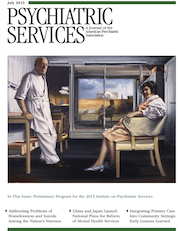Changes in Suicide Rates and in Mental Health Staffing in the Veterans Health Administration, 2005–2009
Abstract
Objective
Between 2005 and 2009, the Veterans Health Administration (VHA) enhanced its mental health programs and increased outpatient mental health staffing by 52.8%. However, suicide rates among VHA patients remained the same. This study evaluated this finding by examining variability in staffing increases between VHA’s 21 regional networks (Veterans Integrated Service Networks) (VISNs) and associations with suicide rates.
Methods
Suicide rates among VHA patients were derived from the National Death Index and VHA clinical and administrative records for 2005 and 2009. Comparisons across VISNs used measures of proportional change in mental health staffing (overall and in inpatient, residential, intensive case management, and outpatient programs) and comparable measures of mental health staffing per 1,000 mental health patients.
Results
Significant correlations were found between proportional changes from 2005 to 2009 in suicide rates and outpatient mental health staffing (r=–.453, p=.039) and outpatient mental health staffing per 1,000 patients (r=–.533, p=.013). The ten VISNs above the median in proportional changes in mental health staffing had average decreases in suicide rates of 12.6% while those below had increases of 11.6% (p=.005). For proportional changes in mental health staffing per 1,000 patients, those above the median had decreases of 11.2% and those below had increases of 13.8% (p=.014). For the average VISN, it would have required a 27.5%–36.8% increase in outpatient staff over 2005 levels to decrease suicide rates by 10%.
Conclusions
Mental health enhancements in VHA were associated with decreases in suicide rates in VISNs where the increases in mental health outpatient staffing were greatest.



